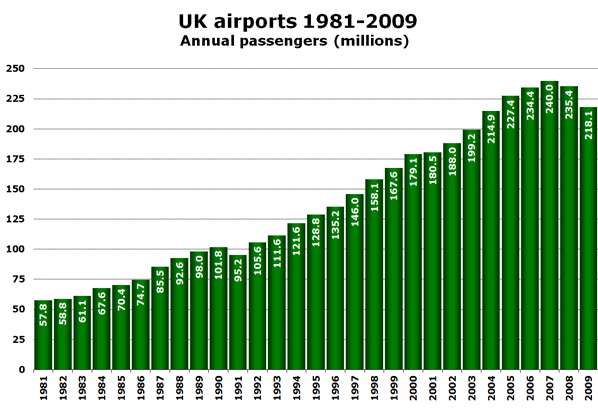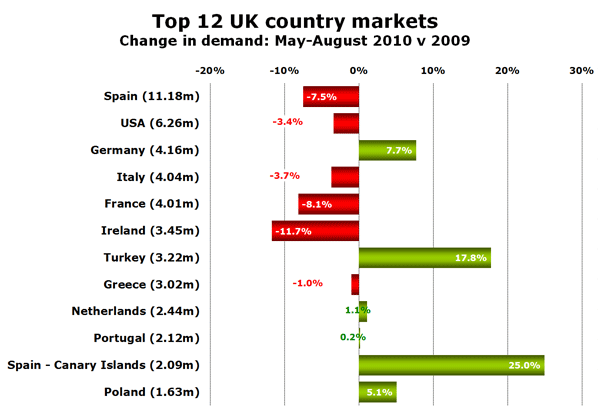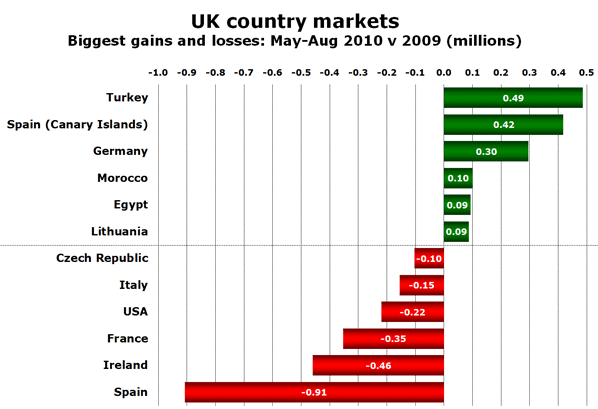Leading UK country markets show significant changes this summer as overall international traffic shows no growth
a week to Geneva (17 December to 24 April 2011). LBIA’s fortunes – up by almost
4% by end-August – have contrasted with the UK overall which looks set to post
a third successive year of declines. However, there was only great happiness at
LBIA today where Tony Hallwood, Commercial and Aviation Development Director,
declared: "easyJet’s high frequencies will allow far more than just weekly and
weekend leisure ski breaks, but will also attract business travel and inbound
tourism to Yorkshire." When asked about any further easyJet routes to LBIA, Ali
Gayward, easyJet UK Commercial Manager was also optimistic: "We will ensure the
success of the new route first, but we are always looking for new opportunities.”
slight downward trend (and about to get a further kick in the teeth from the doubling
of the government’s treasury boosting Air Passenger Duty) it is worth remembering
that the country’s airports still handle more passengers than any other country
in Europe. Passenger numbers may have fallen two years running for the first time
in over 30 years (and will probably fall again this year) but UK airports still
saw over 218 million passenger movements in 2009, more than in Spain (187 million),
Germany (182 million), France (140 million) and Italy (130 million).

followed by the consequences of the Icelandic volcano eruption in April made for
a bad first four months. But since then there have been fewer ‘excuses’ for poor
performance. Passenger numbers across the UK’s airports in June, July and August
were remarkably similar to last year so anna.aero this week takes a closer at
what lurks beneath this apparent stability in demand. By comparing international
traffic from UK airports for the period May to August in 2010 with the same period
in 2009 some interesting and notable variations can be seen.
Canary Islands, Germany, Turkey up; France, Ireland, Spain down
examined is just 240,000. In May to August 2009 there were 70.62 million international
passengers at UK airports compared with 70.38 million a year later, a difference
of just 0.3%. Among the biggest 12 country markets (as defined by the CAA) nine
of them reported a change of more than 3% (either positive or negative) since
last year.

summer, with only Germany (the healthiest of the European economies?) reporting
growth. The surge in traffic to Turkey and the Canary Islands also suggests that
Brits were still more than happy to take overseas holidays if the price was right.
The Canary Islands in particular have benefited from new Ryanair services from
several UK airports, much to the annoyance of the traditional charter carriers.
recently been declining but there are signs that the market is now picking up
once more. Not surprisingly the Irish Tourism tax introduced last May has continued
to take its toll on the UK – Ireland market where the impact of a flat €10 surcharge
has been felt more keenly as the resultant fare increase is higher given the lower
average fares normally associated with such a short-haul market.
Turkey can’t wait for Christmas
becomes the fastest-growing market with an additional 490,000 passengers during
these summer months. Two other non-EU leisure markets, Egypt (+10%) and Morocco
(up 60%), also make the top six in terms of volume growth along with Lithuania.
Here the launch of new scheduled services by Ryanair from Kaunas to Bristol, Edinburgh
and London Gatwick have helped stimulate demand, as well as services from the
capital Vilnius to London Gatwick (with airBaltic), and Edinburgh and London Stansted
(with the now grounded Star1). As a result the Lithuanian market is up 80% this
summer compared with 2009.

900,000 passengers from the UK in just four months. Most of the other big volume
losses came in large markets such as France, Ireland, Italy and USA. The appearance
of the Czech Republic (basically Prague) demonstrates how holiday trends can change
rapidly. A few years ago Prague was one of the fastest-growing destinations in
the UK thanks primarily to its relatively cheap alcohol, making it a trendy destination
for the UK’s short weekend break market, travelling on low-cost carriers. However,
demand is down 18% this summer as the city suffers from what might be termed "Bilbao
syndrome". And from this winter CSA Czech Airlines will withdraw from the UK market
completely, axing its last remaining services to London Heathrow and Manchester.
markets weather the storm best in 2011. However, the combination of this further
taxation, the cancelled Heathrow runway, and the beautiful timing of a fragile
recovery, could all conspire to produce another decline in air travel demand for
an unprecedented fourth straight year in 2011 as the UK government sees if it
can ruin the UK air transport industry’s must-envied competiveness in the same
way that strikers self-destructed British car manufacturing in the 1970s.
